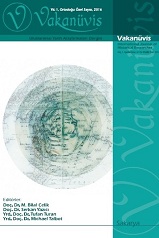Orta Asya Taş Heykellerine Anadolu’dan İstisnai Bir Örnek: İnönü Taş Heykeli
An Outstanding Example of Central Anatolia to Central Asian Stone Sculptures: İnönü Stone Statue
Author(s): Nurfeddin Kahraman, Refik Arıkan, Mehmet Can ÇetinSubject(s): Archaeology, Museology & Heritage Studies, Geography, Regional studies, Cultural Anthropology / Ethnology
Published by: Serkan YAZICI
Keywords: İnönü; Human Shaped Stone Sculpture; Balbal; Turkish Culture;
Summary/Abstract: Death depends on the culture to which it belongs is one of the most important events of human being, where life ends or a new life begins. When we examine the history of humanity, death is accepted as a transition to a new life, and this situation also manifested in the form of deadly burials. The rooms of the tombs seen among the Turks and the sculptures erected for the measurements can be considered as a reflection of this. In this respect, tombs and grave stones are valuable for historical documents in terms of presentation of Turkish culture. While living in Central Asia, the Turks created their own civilization and transferred these experiences to places where they traveled with migrations. Although changes in time, place and belief differentiate the practices of the Turkish civilization of Central Asia, it seems possible to follow cultural traces in terms of historical continuity. While the human-shaped stone sculpture that we found in the central cemetery of İnönü district in Eskişehir occupies an important position in the name of bearing the traces of the cultural climate of Central Asia; it is also important for the history of colonization of the Turks in Anatolia. Despite the presence of human made stone sculptures or balbals in various parts of Anatolia, these are usually made by scraping the stone. However, the stone sculpture we have found is very similar to the examples of Central Asia. In addition to this, another feature that makes our results outstanding is the fact that this is the first discovery in Western Anatolia. In addition, examples were also found in field research conducted in the region to corroborate this conclusion.
Journal: Vakanüvis- Uluslararası Tarih Araştırmaları Dergisi
- Issue Year: 4/2019
- Issue No: Spec.issue
- Page Range: 1-20
- Page Count: 20
- Language: Turkish

